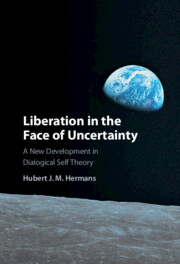Book contents
- Liberation in the Face of Uncertainty
- Liberation in the Face of Uncertainty
- Copyright page
- Dedication
- Contents
- Figures
- Tables
- Preface
- Acknowledgments
- Introduction
- Chapter 1 Playing with Plato
- Chapter 2 Centralization and Decentralization of the Self
- Chapter 3 The Other as Heaven and Hell
- Chapter 4 Re-enchantment of the World
- Chapter 5 Imprisonment and Liberation of the Self
- Chapter 6 Uncertainty in the Self
- Chapter 7 Multiple Well-Being and Other-Inclusive Happiness
- Glossary
- References
- Index
Chapter 5 - Imprisonment and Liberation of the Self
Published online by Cambridge University Press: 06 January 2022
- Liberation in the Face of Uncertainty
- Liberation in the Face of Uncertainty
- Copyright page
- Dedication
- Contents
- Figures
- Tables
- Preface
- Acknowledgments
- Introduction
- Chapter 1 Playing with Plato
- Chapter 2 Centralization and Decentralization of the Self
- Chapter 3 The Other as Heaven and Hell
- Chapter 4 Re-enchantment of the World
- Chapter 5 Imprisonment and Liberation of the Self
- Chapter 6 Uncertainty in the Self
- Chapter 7 Multiple Well-Being and Other-Inclusive Happiness
- Glossary
- References
- Index
Summary
Two imprisoning factors, rumination and loneliness, on the individual level, and two imprisoning factors, social isolation and over-positioning economy, at the collective level are extensively described. Several implications for the organization of the self in contemporary society are outlined: the increasing density and heterogeneity of I-positions, frequency of “visits” by unexpected positions, and larger “position leaps.” Then, the phenomenon of “over-positioning economy” as one of the main implications of neoliberalism is discussed in more depth. A sociological theory is introduced to account for the “asymmetrical penetration” of the economic value sphere into other value spheres (e.g., education, science, love). Also, on the level of the self, a one-sided penetration occurs as economic positions, such as consumer and entrepreneurial positions, are increasingly influencing other I-positions that, as a consequence, are at risk of losing their uniqueness. In all these cases, possible trajectories into the direction of self-liberation are sketched.
- Type
- Chapter
- Information
- Liberation in the Face of UncertaintyA New Development in Dialogical Self Theory, pp. 162 - 195Publisher: Cambridge University PressPrint publication year: 2022

